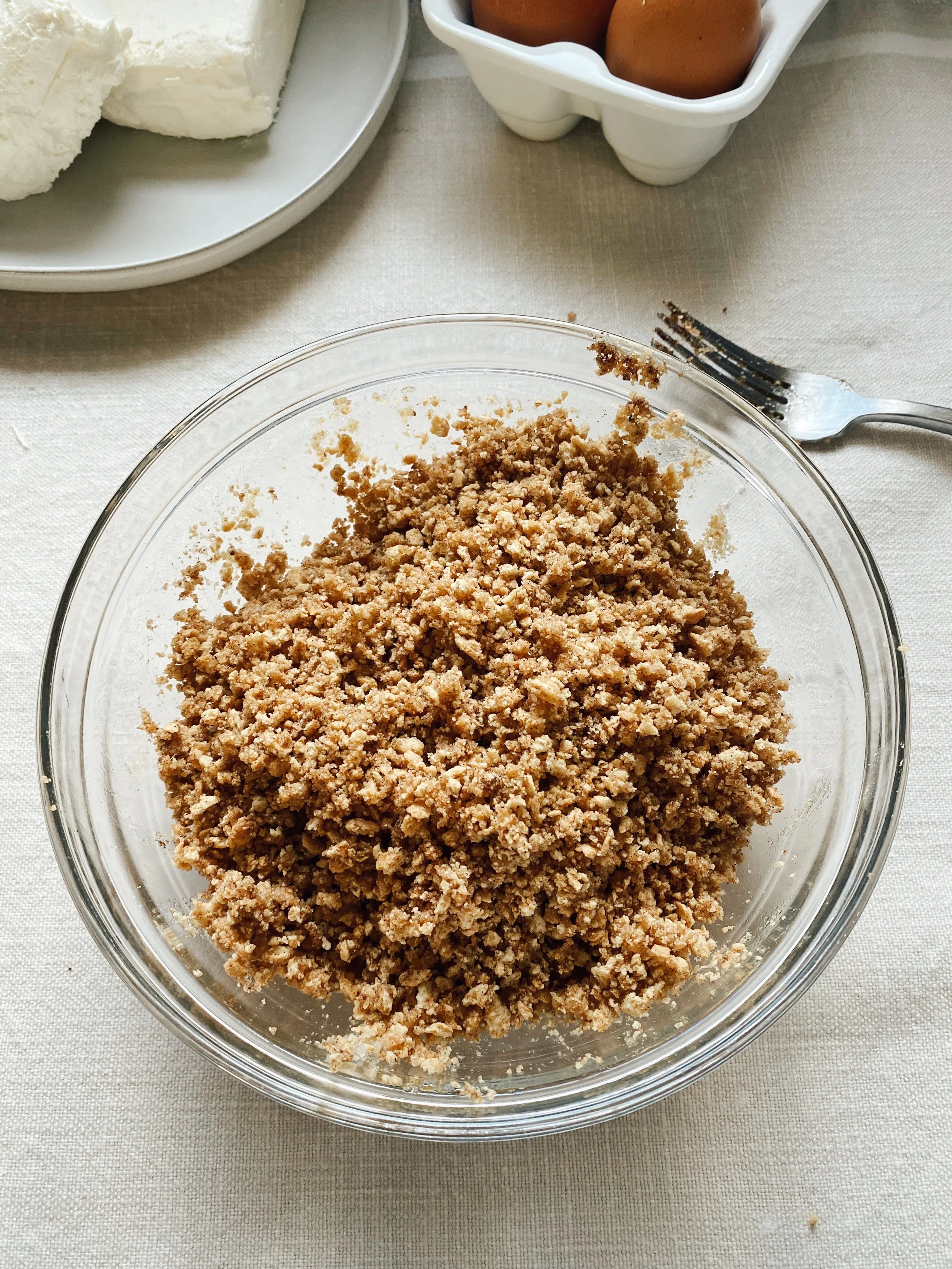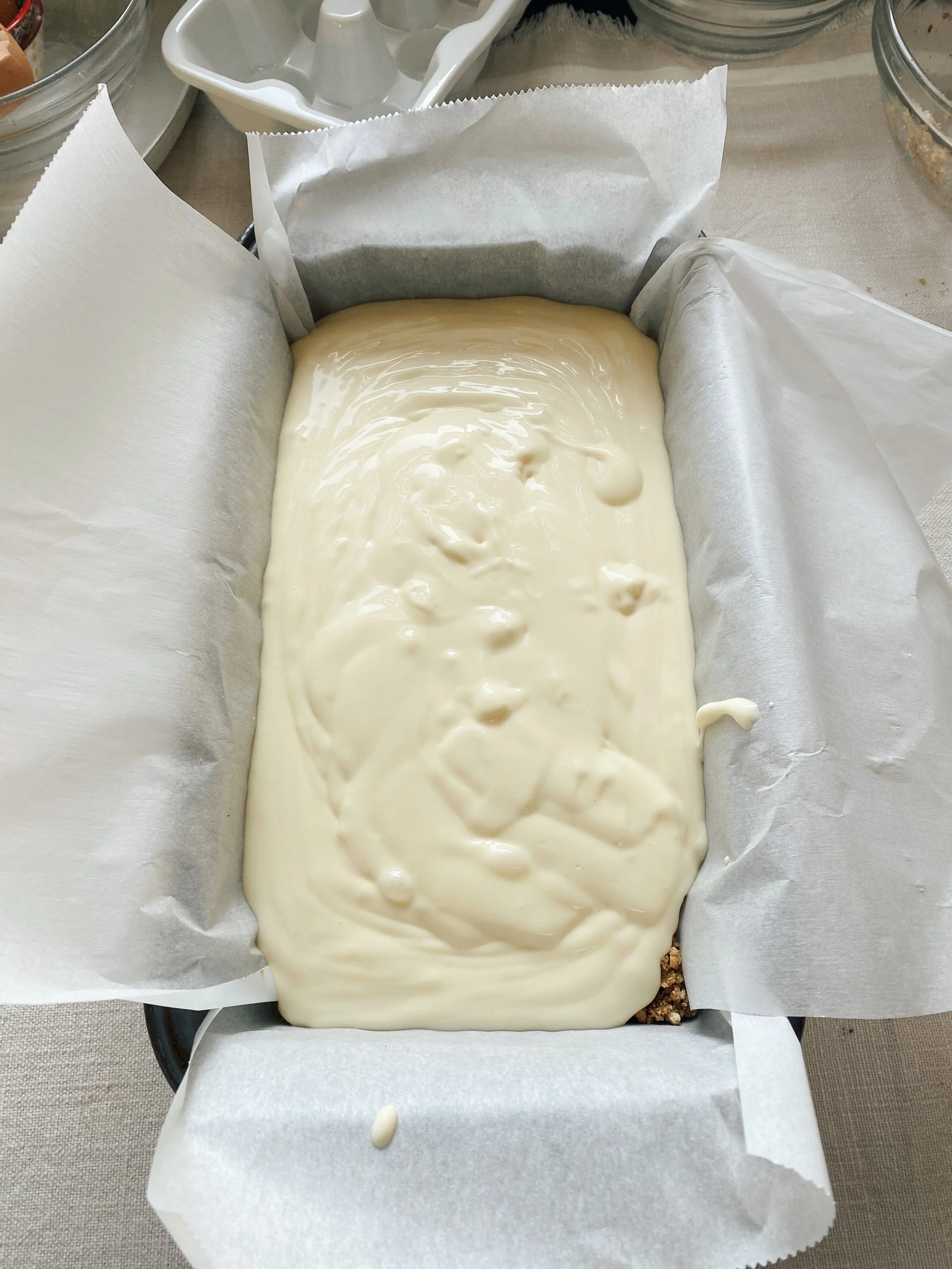Loaf Pan Chocolate Swirl Cheesecake
Loaf Pan Chocolate Swirl Cheesecake
Ingredients
Instructions
- Preheat oven to 325 degrees
- Line a loaf pan with parchment paper so that the excess parchment lays over the sides of the pan. This will help remove the cheesecake when it is done. See details below
- In a food processor, pulverize the graham crackers until the largest chunks are pea sized
- In a bowl, combine graham cracker crumbs, cinnamon, sugar, and a pinch of salt
- Melt butter and mix into graham cracker mixture. The mixture should look like wet sand
- Press mixture into the bottom of the lined loaf pan
- In a large bowl, cream cream cheese with a hand mixer (or with the paddle attachment of a stand mixer)
- Add in sugar, beat to thoroughly combine
- Add in vanilla, lemon juice, and flour. Beat to thoroughly combine
- Mix in eggs one at a time, making sure that each egg is completely combined before adding in the next. Scrap the sides and bottom of the bowl between additions
- Mix in sour cream to combine
- In a small bowl, add in chocolate chips and pour heavy whipping cream on top. Microwave for 1 minute at half-power. Use a fork or whisk to stir ganache. It will slowly come together as you continue mixing. If solid chocolate remains, microwave in 30 second increments at half power until melted. Ganache is ready once it is a smooth, glossy consistency
- Pour the cheesecake batter into the loaf pan and tap lightly to even
- Using a spoon, dollop chocolate ganache on top. Use a toothpick to lightly swirl ganache. I like to drip ganache in a zig zag pattern from the short side of the pan and drag the toothpick vertically from top to bottom.
- Place the loaf pan into a large casserole dish. Pour very hot (almost boiling water) water into the casserole dish until it reaches halfway up the sides of the loaf pan
- Bake for 1 hour. Edges should be set (lightly press with your finger to test) and center should still be jiggly. Try not to peak early - cheesecake is more likely to crack when the oven temperature changes!
- Turn oven off and leave the cheesecake inside for another 15 minutes
- Crack open the door of the oven, still leaving the cheesecake inside. Let cool for 1 hour inside the cracked oven
- Remove cheesecake from oven and remove loaf pan from water bath. Move the loaf pan into the refrigerator for at least 5 hours but preferably overnight.
- Use parchment paper to remove cheesecake from pan. Slice and serve!
Details
To get set up, preheat the oven to 325 degrees. If you don’t already have an oven thermometer, I highly recommend you get one! They are small and inexpensive but can seriously improve your baking game! You would be surprised how inaccurate oven temperature can be.
Line a loaf pan with parchment paper. The best trick for this is to measure out a piece of parchment that is long wide enough to line both sides and the bottom of the pan with extra hanging over the sides. Next, set the pan on the parchment so that the long side of the pan is alone the long side of the parchment. Mark the length of the pan and cut this piece of parchment off. Overlap these two pieces in a cross and press into the pan, now all sides should be covered! It will look like the picture below. The excess parchment on the sides will be used to lift the cheesecake out of the pan later.
On to the cheesecake. First, we are going to assemble the graham cracker crust. Take your 9 full sheets of graham cracker and put them into a food processor. Run the processor on high for a few seconds then pulse on low until the largest chunks are the size of peas. The crumbs will not all be the same size, thats okay! Pour the graham cracker crumbs into a small bowl, add in the cinnamon, sugar, and a pinch of salt. Melt the butter in the microwave and pour over the graham cracker mixture. Mix with a fork, spoon, or your hands (my favorite method) until the entire mixture looks like wet sand. Press the mixture evenly into the bottom of the loaf pan.
In a medium bowl, cream the cream cheese with a hand mixer (or in the bowl of a stand mixer with a paddle attachment). Pour in the sugar and mix until completely combined. Beat in lemon juice, vanilla, and flour. Beat in eggs one at a time, ensuring that each is completely combined before adding the next. Make sure to scrape sides and bottom of the bowl between additions to get everything fully incorporated. Finally, add in sour cream and beat until lightened in color and slightly thicker in texture, about 1 minute. Pour cheesecake batter into loaf pan and lightly tap pan on the counter to even the top.
Put the chocolate chips in a small microwave safe bowl and pour heavy cream on top. Heat in the microwave for 1 minute at half-power. It is very important to only use half-power when making chocolate ganache. Using full power on the microwave will scorch the chocolate which means you will have to start again. After one minute, use a fork or whisk to stir the ganache. Be patient, it will appear to not be melted enough but will slowly come together as you mix. You are looking for a thick, glossy texture that has no clumps remaining. If you still have solid chocolate chips, microwave for 30 second intervals at half-power until melted.
Drizzle the ganache onto the cheesecake. I like to use a zigzag pattern but anything works! It doesn’t need to look pretty just set. Use a toothpick to lightly swirl the ganache. I drag the toothpick vertically through the zigzag pattern as seen in the picture below.
We are using the water bath method to cook the cheesecake. This helps disperse the heat and ensure even cooking. Place the loaf pan into a casserole dish (a cake pan or roasting pan work as well). Pour very hot (almost boiling) water into the casserole dish until it reaches about halfway up the sides of the loaf pan.
We are now ready to bake! Place the casserole dish into the oven and bake for about 1 hour. Try not to take a peek inside! Cheesecakes are highly sensitive to temperature changes and are likely to crack if the oven temperature drops quickly. At the end of one hour, the edges of the cheesecake should be set and the center still jiggly. Lightly press your finger on the edge of the cheesecake to check.
Turn the oven off and leave the cheesecake in the oven with the door closed. Crack open the door of the oven and continue to cool for 1 hour longer. This method allows the cheesecake to cool slowly and evenly, preventing cracking. After 1 hour, remove casserole dish from oven and remove loaf pan from water bath. Place the loaf pan into the fridge and leave for at least 5 hours, but preferably overnight.
Once completely cool, remove from loaf pan by using the overhanging parchment. Peel parchment from cheesecake. Slice and serve!
Although the cheesecake is great all by itself, I love adding a spoonful of my strawberry compote on top. Let me know if you try it out!
















